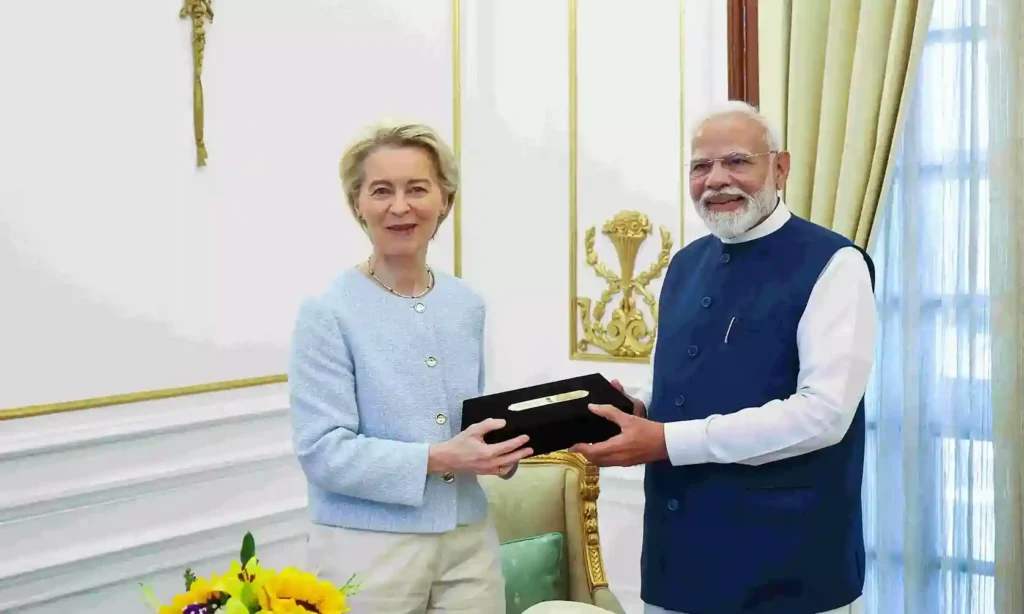New Delhi: In a landmark decision that signals a transformative phase in Indo-European relations, the European Council has formally approved the New Strategic EU-India Agenda. This comprehensive framework, unveiled just weeks ago, charts a bold course for collaboration across economics, technology, security, and global connectivity. Announced on October 20, 2025, the approval underscores the EU’s commitment to elevating its Strategic Partnership with India—first forged in 2004—to unprecedented heights amid rising geopolitical uncertainties.
The agenda’s timely endorsement comes as both sides race to seal a Free Trade Agreement (FTA) by year’s end, promising enhanced market access, barrier removal, and sustainable development provisions. With bilateral trade already soaring to €120 billion in 2024—making the EU India’s top goods trading partner—this pact could unlock trillions in mutual prosperity.

The Five Core Pillars of the EU-India Strategic Agenda
At the heart of this agenda lie five priority pillars, meticulously designed to tackle shared opportunities and threats in today’s volatile world. These pillars were outlined in a pivotal Joint Communication from the European Commission and the EU’s High Representative, now fully backed by the 27-member bloc’s leaders.
1. Prosperity and Sustainability: Fueling Economic Growth and Green Transition
The first pillar zeroes in on prosperity and sustainability, emphasizing job generation, decarbonization efforts, and resilient supply chains. Central to this ambition are accelerated negotiations for an EU-India Free Trade Agreement (FTA) and an Investment Protection Agreement (IPA).
These deals aim to dismantle tariffs, streamline regulations, and foster equitable growth. For India, the EU represents a vital gateway to advanced markets; for Europe, India’s burgeoning manufacturing base offers diversification from riskier dependencies. The council’s conclusions explicitly hail these efforts as “balanced, ambitious, mutually beneficial, and economically meaningful,” with a target wrap-up before December 31, 2025.
This pillar aligns with broader goals like circular economies and clean energy transitions, positioning EU-India ties as a model for sustainable globalization.
2. Technology and Innovation: Pioneering the Next Tech Frontier
Collaboration on critical and emerging technologies forms the second pillar, with deepened ties in digital infrastructure and research. Key mechanisms include the EU-India Trade and Technology Council and integration into Horizon Europe, the EU’s flagship €95.5 billion research program.
Expect joint advancements in AI, semiconductors, quantum computing, and 6G networks. This pillar addresses supply chain vulnerabilities exposed by recent global disruptions, ensuring both regions lead in innovation rather than lag behind competitors.
3. Security and Defence: Building Trust in a Fractured World
In a nod to escalating global tensions, the security and defence pillar marks a significant evolution. It focuses on countering threats from geopolitical rivalries and rapid technological shifts. Concrete actions include synchronized strategies for the Indo-Pacific region and upholding a rules-based maritime order.
The council’s statement highlights plans for a dedicated Security and Defence Partnership, potentially opening doors to defence industrial cooperation. This could involve co-development of military hardware, intelligence sharing, and joint exercises—grounded in “mutual trust and respect.”
Notably, the EU pledges continued dialogue with India on Russia’s war of aggression against Ukraine, reflecting nuanced positions while prioritizing stability.
4. Connectivity and Global Issues: Bridging Continents and Crises
The fourth pillar targets connectivity and global issues, enhancing regional links, multilateral governance, and third-country partnerships. A flagship initiative is bolstering the India-Middle East-Europe Economic Corridor (IMEC), a mega-infrastructure project rivaling China’s Belt and Road.
Complementing this is the EU’s Global Gateway strategy, which mobilizes €300 billion for sustainable infrastructure worldwide. EU-India synergy here promises faster trade routes, digital highways, and energy security from India to Europe via the Middle East.
5. Enablers Across Pillars: The Glue Holding It All Together
Overarching all pillars are enablers that ensure seamless execution: streamlined skills mobility for professionals, robust knowledge exchange programs, boosted business engagement, and fortified institutional cooperation. These cross-cutting elements will amplify impacts, from visa reforms for Indian talent to joint think tanks and corporate matchmaking.
Historical Foundations: From 1962 Diplomacy to 2025 Ambition
The EU-India relationship boasts deep roots. India was among the earliest nations to forge diplomatic ties with the European Economic Community in 1962. By 2004, this blossomed into a full Strategic Partnership, evolving through summits, dialogues, and crises.
Economically, the partnership shines. Bilateral goods trade hit €120 billion in 2024, cementing the EU as India’s premier trading bloc. Foreign Direct Investment (FDI) from the EU into India totals a staggering USD 107.27 billion from April 2000 to December 2023, fueling sectors like renewables, autos, and IT.
This agenda builds on February 2025’s historic EU College of Commissioners’ visit to India—the first-ever to the Indo-Pacific. That trip committed both sides to a “new chapter,” emphasizing shared prosperity, security, and global problem-solving.
European Council’s Key Directives and Global Commitments
The October 20 conclusions, adopted in Brussels, task the European Commission with fleshing out and implementing the agenda per the Joint Communication. Highlights include:
- FTA Push: Urging swift conclusion with focus on market access, trade barrier elimination, and sustainability clauses.
- Defence Dialogue: Advancing a formal partnership for industrial ties “when appropriate.”
- Multilateralism: Joint defence of the UN Charter, WTO-led trading system, and rules-based order.
- Values Alignment: Integrating promotion of democratic norms, international law, human rights—including women’s and children’s rights—into every facet.
The council stressed EU-India’s “joint capacity and responsibility” in these areas, especially amid challenges like Ukraine and Indo-Pacific flashpoints.
Stakeholder Reactions and Next Steps
EU Ambassador to India Herve Delphin celebrated the approval on X (formerly Twitter), calling it “news from Brussels coming with the Diwali spirit!” He noted the unanimous support from all 27 member states for this “ambitious and comprehensive strategic agenda.” Delphin flagged the upcoming joint roadmap for the early 2026 EU-India Summit in Delhi.
Indian officials, including Commerce Minister Piyush Goyal, have echoed enthusiasm, tying it to parallel pacts like the India-EFTA trade agreement implementation from October 1, 2025. Analysts predict the FTA could add €100 billion annually to bilateral trade within a decade.
Why the EU-India Strategic Agenda Matters Now
This agenda arrives at an inflection point. With China’s assertiveness, US retrenchment, and supply chain shocks, EU-India alignment offers strategic depth. For India, it diversifies partnerships beyond traditional allies; for the EU, it counters isolationism.
Challenges remain—agricultural sensitivities in FTA talks, differing Ukraine stances—but mutual interests prevail. The New Strategic EU-India Agenda isn’t just policy; it’s a blueprint for 21st-century multipolarity.
As Delhi prepares to host the 2026 summit, watch for accelerated negotiations. This could redefine EU-India relations for generations, blending Europe’s tech prowess with India’s demographic dividend.
FAQs
1. What are the five priority pillars of the EU-India Strategic Agenda?
The agenda is built on five core pillars:
Enablers: Supports skills mobility, knowledge exchange, business ties, and institutional links across all pillars.
Prosperity and Sustainability: Drives economic growth, jobs, decarbonization, and supply chain resilience, with goals to finalize the EU-India FTA and Investment Protection Agreement (IPA).
Technology and Innovation: Boosts cooperation on emerging tech, digital infrastructure, and research via the Trade and Technology Council and Horizon Europe.
Security and Defence: Tackles global threats, Indo-Pacific coordination, and a potential Security and Defence Partnership for industrial collaboration.
Connectivity and Global Issues: Enhances projects like IMEC (India-Middle East-Europe Corridor) and Global Gateway.
2. When do the EU and India plan to finalize the Free Trade Agreement (FTA)?
Both sides aim to conclude a balanced, ambitious, and mutually beneficial FTA by December 31, 2025. The European Council emphasized enhanced market access, trade barrier removal, and sustainable development provisions to boost bilateral trade, which reached €120 billion in 2024.
3. What new areas of cooperation does the agenda introduce in security and defence?
The agenda advances a Security and Defence Partnership based on mutual trust, including potential defence industrial cooperation. It covers Indo-Pacific strategies, rules-based maritime order, and ongoing EU-India dialogue on Russia’s war in Ukraine, marking a shift from traditional economic focus.
4. What is the historical background of EU-India relations mentioned in the agenda?
India established diplomatic ties with the European Economic Community in 1962—among the first countries to do so. The partnership was upgraded to Strategic status in 2004. Economically, EU FDI into India totals USD 107.27 billion (April 2000–December 2023), and the EU is India’s largest goods trading partner.
5. What are the next steps after the European Council’s approval?
The European Commission will articulate and implement the agenda based on the recent Joint Communication. A joint EU-India roadmap is expected soon, leading to the 2026 EU-India Summit in Delhi. EU Ambassador Herve Delphin highlighted unanimous 27-member state support, calling it an “ambitious strategic agenda.”

